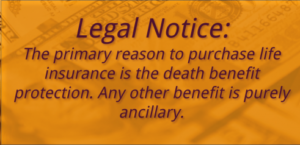Whereas the 4% rule is the safe distribution rate for traditional retirement assets, 8% is the equivelent safe income rate for a maximum over-funded life insurance policy.
The 8%-Rule
Understand that when you take loans against your policy to fund your retirement, your savings “bucket” stays full. Not only does it stay full, but it also continues to grow for as long as you live. Every state has language in its statutes that require insurance companies to make loans to their policy owners. That means that he insurance company must make loans to you that are secured by your cash value collateral. THIS is the magic that makes life insurance so powerful.
Like all loans, the insurance company charges interest. So if you borrow $10,000 at 5% interest, there will be $500 of interest do at the end of the year. What happens is that the insurance company loans you the $500 to pay themselves the interest and they add $500 to your loan balance. They allow you to finance the interest charges.
During each year of retirement, you will continue to borrow money from the insurance company. Each year the insurance company will loan you the money to pay themselves the interest on your entire loan balance. If you have followed this so far, you will realize that you a loan balance that is growing at a compounding rate.
Be mindful that the collateral that is securing the loan is still growing and compounding and is providing 100% collateral for the loan balance! During that first year, in the example above, the $10,000 of cash value that is securing the loan also earned interest or dividends. If the cash value earned 5%, then there was $500 of growth in the cash value… just enough to be collateral for the additional $500 loan to finance the interest.
So as long as the cash value earns at least the same or better than than the loan rate, the policy loans will be secured. Any policy you choose for a LIRP should have what is called a “Wash Loan” feature. This simply means that the loan rate for policy loans will exactly equal the crediting rate on the cash value. Most good policies have this feature.
Now, let’s think about what would happen if the interest rates were different. What if the growth on the cash value exceeds that of the policy loan interest rate?
How can the cash value earn more than the borrowing rate?
Well, if the cash value is growing at a faster rate than the loan balance, then there would be additional cash value that could serve as collateral for loans. If you have more cash value, you can take more income in the form of loans. The ability of the interest crediting strategies in an IUL to capture a portion of the Equity Premium is the reason why we expect the rate of growth on an IUL to exceed the rate of growth of the cash value on a Whole Life.


